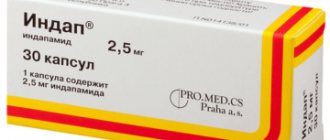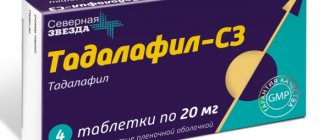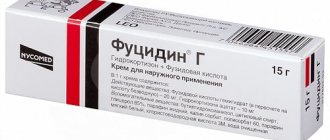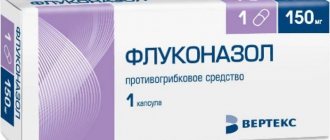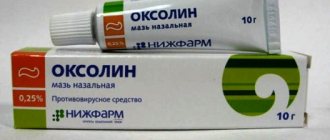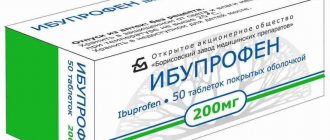Cetirizine is an antiallergic drug, a histamine H1 receptor blocker.
Description and application:
- Tradename
- International nonproprietary name
- Dosage form and description
- Composition and release form
- Pharmacological group
- Pharmacological properties
- Pharmacodynamics
- Pharmacokinetics
- Indications for use
- Contraindications
- Directions for use and doses
- Side effect
- Overdose
- Interaction with other drugs
- special instructions
- Carefully
- Use during pregnancy and lactation
- Interaction with alcohol
- Impact on the ability to drive vehicles and other mechanical means
- Storage conditions and shelf life
- Conditions for dispensing from pharmacies
- Analogs
- Opinion survey results
Composition and release form
For 1 tablet:
- Active ingredients: cetirizine dihydrochloride - 10.00 mg;
- Excipients: microcrystalline cellulose - 40.00 mg, lactose monohydrate - 63.50 mg, colloidal silicon dioxide - 0.50 mg, magnesium stearate - 1.00 mg;
- Shell: Opadry OY-GM-28900 white (hypromellose (E464)) - 0.94 mg, polydextrose - 0.94 mg, titanium dioxide (E171) - 0.94 mg, macrogol-4000 - 0.18 mg.
10 tablets in a blister made of aluminum foil/PVC/PVDC. 1, 2 or 3 blisters with instructions for use are placed in a cardboard pack.
Analogues of the drug
Today, the most effective analogues of Cetirinax are such drugs as Cetrin, Zodak, Analergin, Alercetin and Cetirizine. However, Zyrtec is the most popular among patients. So what to choose: Zyrtec or Cetirinax?
Firstly, drugs vary in price. So, the cost of the first one, on average, is about 240-280 rubles, Cetirinax costs less - 70-90 rubles. However, both drugs have the same effect, since they contain the same active ingredient - cetirizine.
Zirtek is produced by a company with branches in Italy, Belgium and Switzerland, Cetirinax is also an imported product owned by an Icelandic company. The difference is that Zyrtec is a proprietary name for the drug, and the risk of buying a counterfeit or low-quality product is much lower than when choosing generics.
In any case, when choosing Zyrtec or Cetirinax, you should definitely consult with your doctor.
So, this article reviewed the drug “Cetirinax” (instructions for use, interactions with other drugs, features of administration and possible analogues). In general, reviews from patients using this drug are positive. Particularly noted is the affordable price, lack of addiction to the drug, rapid action and minor side effects. However, it is necessary to take Cetirinax or its analogues only as prescribed by a doctor.
Pharmacological properties
Pharmacological action - antiallergic, H1-antihistamine.
Pharmacodynamics
Cetirizine is a competitive histamine antagonist, a metabolite of hydroxyzine, and a blocker of H1 histamine receptors. Inhibits vasoactive intestinal peptide (VIP), substance P, and neuropeptides involved in the development of an allergic reaction.
Prevents the development and facilitates the course of allergic reactions, has antipruritic and antiexudative effects. Affects the early stage of allergic reactions, limits the release of inflammatory mediators at the “late” stage of the allergic reaction, reduces the migration of eosinophils, neutrophils and basophils. Reduces capillary permeability, prevents the development of tissue edema, relieves spasm of smooth muscles.
Eliminates skin reactions to the introduction of histamine, specific allergens, as well as to cooling (with cold urticaria).
Reduces histamine-induced bronchoconstriction in mild bronchial asthma. It has virtually no anticholinergic and antiserotonergic effects. In therapeutic doses it practically does not cause a sedative effect.
The therapeutic effect develops 2 hours after administration, reaching a maximum after 4 hours, and lasts more than 24 hours. During a course of treatment, tolerance to the antihistamine effect of cetirizine does not develop. After stopping treatment, the effect lasts up to 3 days.
Pharmacokinetics
Suction. After oral administration, it is quickly absorbed. Maximum plasma concentration (Cmax) is achieved after 1 hour. Taking the drug with food does not affect the amount of absorption, but the rate of absorption is slightly reduced (the time to reach Cmax increases by 1 hour).
Distribution. Cetirizine binds to plasma proteins by 93%. Volume of distribution (Vd) - 0.5 l/kg. Excreted in breast milk. Does not accumulate.
Metabolism. In small quantities it is metabolized to form a pharmacologically inactive metabolite (unlike other H1-histamine receptor blockers, which are metabolized in the liver with the participation of the cytochrome P450 isoenzyme system).
Excretion. 60% of the drug is excreted unchanged by the kidneys within 96 hours and about 10% is excreted through the intestines. The half-life (T1/2) is 7–10 hours. It is practically not removed by hemodialysis.
Pharmacokinetics in special clinical situations. T1/2 for children aged 6–12 years - 6 hours. In patients with impaired renal or liver function, the elimination of the drug slows down and T1/2 increases.
Cetirinax
Cetirinax is an antiallergic drug.
Pharmacokinetics
Suction
The drug is absorbed quickly from the gastrointestinal tract.
An hour after oral administration, Cmax in blood plasma is reached. Concomitant food intake does not directly affect the degree of absorption of Cetirinax, but reduces Cmax by 23% and lengthens the time to reach Cmax by one hour.
Distribution
Binding to plasma proteins is fixed at 93% and does not change at cetirizine concentrations in the range of 25-1000 ng/ml.
When cetirizine is prescribed from 5 mg to 60 mg, the pharmacokinetic parameters change linearly.
Css in blood plasma when taking cetirizine 1 time per day for 10 days at a dose of 10 mg is 310 ng/ml and is fixed after 0.5-1.5 hours.
Vd – at the level of 0.5 l/kg. Absorbed into breast milk.
Metabolism
In small doses, Cetirizine is metabolized in the liver through O-dealkylation to form a pharmacologically inactive metabolite.
The drug is not prone to accumulation.
Removal
2/3 of the dose taken is excreted unchanged by the kidneys, and about 10% is excreted directly with feces. Systemic clearance of cetirizine is 53 ml/min. In adult patients - T1/2 - 7-10 hours, 6 hours - in children from 6 to 12 years old and the next 5 hours - in children from 2 to 6 years old.
Pharmacokinetics in special cases
In elderly patients, T1/2 increases by 50%, on the contrary, systemic clearance decreases by 40% (due to decreased renal function).
Systemic clearance of Cetirizine in renal failure decreases, T1/2 lengthens, which requires adjustment of the dosage regimen.
In chronic liver diseases, a 50% increase in T1/2 of cetirizine and a 40% decrease in systemic clearance are recorded.
During hemodialysis, the drug is practically not removed.
Side effects
From the digestive system:
- discomfort in the abdominal area;
- dry mouth.
From the side of the central nervous system:
- migraine;
- dizziness;
- headache.
Allergic reactions:
- angioedema;
- itching;
- hives;
- skin rash.
Taking Cetirinax is generally well tolerated, and side effects are observed quite rarely.
Directions for use and dosage
Cetirinax is intended for oral administration. Take the tablets with a small amount of liquid.
For adults and children over 6 years old, one tablet (10 mg) is indicated once a day or 2 times 1/2 tablet (equivalent to 5 mg).
In case of functional renal impairment, a dose of 5 mg per day is indicated, in case of severe chronic renal failure - every other day, 5 mg/day.
The drug can be taken twice a day - 0.5 tablets in the morning and evening.
Directions for use and doses
Inside. The tablets are swallowed completely, without chewing, with a small amount of water, preferably in the evening.
Adults, children over 12 years of age and weighing more than 30 kg
10 mg (1 tablet) 1 time per day.
Children 6–12 years old
With a body weight of more than 30 kg. 10 mg once a day or 5 mg (½ tablet) 2 times a day (morning and evening).
With body weight less than 30 kg. 5 mg (½ tablet) 1 time per day.
In patients with renal failure, dose adjustment depends on the CC value and is presented in the table:
| Group | Creatinine clearance (ml/min) | Dose and frequency of administration |
| Mild chronic renal failure | 50–79 | 10 mg 1 time per day |
| Moderate chronic renal failure | 30–49 | 5 mg per day |
| Severe chronic renal failure | 11–30 | 5 mg once every 2 days |
| End-stage chronic renal failure, patients on hemodialysis | Less than 10 | The drug is contraindicated |
The duration of treatment is selected individually depending on the symptoms of the disease. If drowsiness occurs, the drug should be taken in the evening.
Overdose
If the permissible daily or single dose is significantly exceeded (more than 45-50 mg), symptoms such as drowsiness, excessive dryness of the mucous membranes in the mouth, constipation and urinary retention, causeless and uncontrollable feelings of anxiety, nervousness and increased irritability may occur.
An overdose of the drug requires immediate emergency measures. The patient is given gastric lavage and given sorbents for oral administration (for example, activated carbon). If necessary, symptomatic therapy is possible.
Side effect
The incidence of adverse reactions is classified according to the recommendations of the World Health Organization: very often - at least 10%; often - not less than 1% and less than 10%; infrequently - not less than 0.1% and less than 1%; rarely - not less than 0.01% and less than 0.1%; very rarely - less than 0.01%, including isolated cases.
- From the blood and lymphatic system: very rarely - thrombocytopenia.
- From the immune system: rarely - hypersensitivity reaction; very rarely - anaphylactic shock.
- From the nervous system: infrequently - paresthesia, agitation; rarely - convulsions, movement disorders, aggression, confusion, depression, hallucinations, insomnia; very rarely - disturbance of taste, fainting.
- From the cardiovascular system: rarely - tachycardia, palpitations.
- From the organ of vision: very rarely - accommodation disorders, blurred vision, oculogyric crisis.
- From the gastrointestinal tract: infrequently - diarrhea.
- From the liver and biliary tract: rarely - increased activity of liver transaminases, alkaline phosphatase, γ-glutamyltransferase; very rarely - hepatitis.
- From the skin and subcutaneous tissues: infrequently - itching, rash; rarely - urticaria; very rarely - angioedema, erythema multiforme.
- From the kidneys and urinary tract: very rarely - dysuria, urinary incontinence, difficulty urinating.
- Other: infrequently - asthenia, discomfort; rarely - swelling, weight gain.
Interaction with other drugs
No pharmacokinetic interactions were detected with pseudoephedrine, cimetidine, ketoconazole, erythromycin, azithromycin, diazepam and glipizide.
Concomitant use with theophylline (400 mg per day) leads to a decrease in the overall clearance of cetirizine (the kinetics of theophylline does not change).
Myelotoxic drugs increase the manifestations of hematotoxicity of cetirizine.
The use of cetirizine must be discontinued three days before allergy testing.
It is recommended to exercise caution during the simultaneous use of drugs that have a depressant effect on the central nervous system.
Indications for use of Cetirizine
The drug Cetirizine is prescribed to adults and children over 2 years of age for the treatment of seasonal and year-round allergic rhinitis (runny nose), hay fever, urticaria, conjunctivitis, and atopic dermatitis. Cetirizine effectively suppresses skin reactions also in patients with dermographism and cold urticaria. Reviews of Cetirizine have shown that the drug is well tolerated by children and brings relief when rhinitis is combined with mild or even moderate asthma. In complex therapy, Cetirizine is successfully prescribed for chronic eczema.
special instructions
In some patients, long-term treatment with cetirizine may increase the risk of developing dental caries due to dry mouth. For this reason, careful oral hygiene is necessary during treatment with the drug.
Cetirizine is contraindicated in patients with hereditary galactose intolerance, lactase deficiency and impaired absorption of glucose-galactose.
Carefully
- moderate to severe chronic renal failure;
- age over 65 years;
- simultaneous use with drugs that have a depressant effect on the central nervous system (CNS), such as barbiturates, opioid analgesics, ethanol, benzodiazepine derivatives, zolpidem, etc.
Use during pregnancy and lactation
Cetirizine is contraindicated for use in pregnant women due to insufficient data on safety and effectiveness.
There is no data on the excretion of cetirizine in breast milk; cetirizine should not be used during breastfeeding.
Interaction with alcohol
The drug may enhance the effects of alcohol, so it is recommended to refrain from drinking alcohol while using the drug.
Impact on the ability to drive vehicles and other mechanical means
Caution should be exercised when using the drug due to the possible development of adverse reactions that may negatively affect the ability to drive vehicles and perform potentially hazardous activities that require increased concentration and speed of psychomotor reactions.
Cetirizine Hexal tablets contraindications
- hypersensitivity to cetirizine, other pyrazine derivatives or other components of the drug;
- End-stage renal failure (creatinine clearance less than 10 ml/min);
- lactase deficiency, lactose intolerance, glucose-galactose malabsorption;
- children under 6 years of age;
- pregnancy, lactation period.
Carefully
Chronic renal failure of moderate and severe severity (with creatinine clearance (CC) more than 10 ml/min, dosage regimen adjustment is required), elderly age (glomerular filtration rate may decrease), epilepsy and patients with increased convulsive readiness, patients with predisposing factors to urinary retention .
Use during pregnancy and breastfeeding
There are no data on the clinical use of cetirizine in pregnant women, therefore cetirizine should not be used during pregnancy.
Cetirizine is secreted into breast milk, so breastfeeding should be stopped while using the drug.

